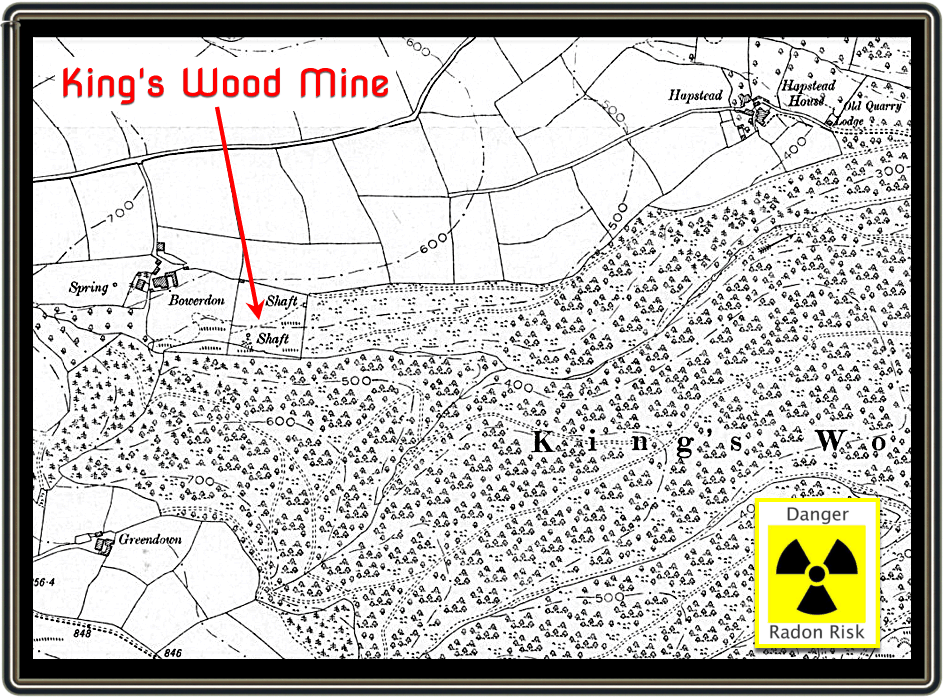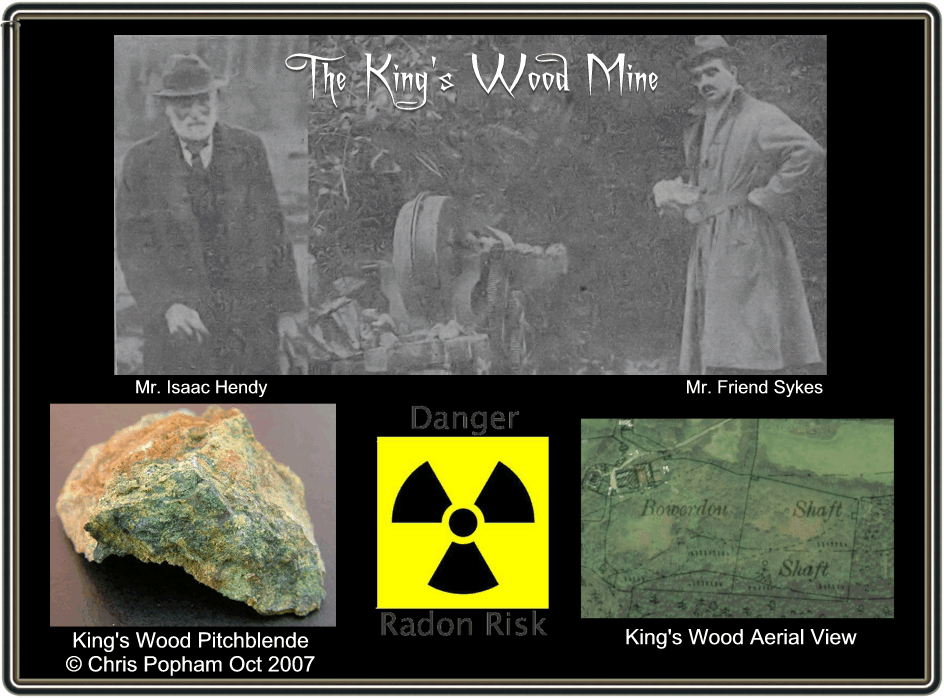
I recently came across a short article in the Mansfield Reporter dated the 24th of January 1919 which began: “A valuable radium discovery – radium is £400,00 an ounce – has been made in a remarkable way at Hapstead on the fringe of Dartmoor.” It then went on to say; “The Mineral Resources Development of the Ministry of Munitions was called in, and on analysis the ore proved to be pitchblende, the ore of radium. The maximum oxide content was over 26%, or thirteen times as rich as the American ore now being imported.” Today pitchblende is commonly known as Uranite and contains a small amount of radium as a radioactive decay product of uranium. As I certainly am no geologist if you want to know more about pitchblende and radium please follow these links, besides it’s the historical aspect which concerns this page.
Having had my curiosity raised I was keen to find out more about this valuable find especially when in comparison at that time gold was fetching around £13.62p per ounce it truly would have been lucrative discovery. After a little bit more digging I then came across a lengthy article in the Western Times dated the 17th of January 1919 which began; “There is quite a romance attached to this priceless find, and it was all told to me yesterday, when Mr. Friend Sykes, the Lord of the Manor and the owner, took me over the mine. I was the first journalist to be given the privilege of seeing this mine, and one of the first half-dozen outside the actual principals to know of its existence.”
Firstly the estate of which Friend Sykes was Lord of the Manor was Brooke Mainbow which was previously owned by the 7th Earl of Macclesfield. Secondly the mine in question is the King’s Wood Mine that was situated at Ordnance Survey grid reference SX 711 666.
During the mid 1800s whilst the estate was in the ownership of the Earl of Macclesfield a man called Robins was working on the estate when he came across what he considered to be signs of some mineral deposits. In a previous occupation he had been a miner and through his prior experiences he considered that what he had found was worth further investigation. Accordingly he applied for and obtained permission to carry out further investigations. Unfortunately no ore baring loads were ever discovered and his money ran out which meant all work had to stop. Despite many efforts he could find nobody willing to invest in his project and so he moved away. After a while and not being one to admit defeat Robins managed to gather some more funds and return to his prospecting. The man’s persistency paid off as true to his instincts a copper bearing lode was discovered and it did not take long for production to begin. At this time there was a young boy called Isaac Hendy working at the mine and it was he who wheeled the first barrow-load of copper out of the mine. It was estimated that at the time nearly 30,000 tons of pure copper ore was extracted. Having made enough money from the mine Robins sold up and then followed the formation of the Wheal Emma and Brookwood mines who remained in production until 1885. Although of no particular relevance to the King’s Wood mine this part of the story did have some influence on the story.
During the early 1900s the Earl of Macclesfield sold his estate and having a desire to settle down in Devonshire (despite of already owning estates in Hampshire and Bournemouth) Friend Sykes bought a large proportion of the estate thus becoming Lord of the Manor. Mr Friend Sykes was by profession a chemical engineer who specialised in the production of acetone from wood which lead him to establish a factory at Bideford. At the time this process was deemed as being commercially nonviable and what little was used was imported. However Sykes was undaunted by this fact and was firmly of the belief that domestic use should be catered for at home. Fortune favours the brave which in this case proved to be true as at the outbreak of World War Once acetone was much in demand for explosive production. It was to Sykes that the Government turned for assistance and before long he became responsible for three factories producing acetone. Once he had assured an adequate supply Friend Sykes retired with the aim of developing his estate from an agricultural point of view. One other thing about Friend Sykes, he had been for many years a keen geologist. So, one day whilst out shooting with his dog in King’s Wood he stumbled across an outcrop which in his opinion contained a valuable lode of some kind and further investigation led him to believe that he had found several more such lodes in the wood. Another factor in this belief was that of the high mineral content found at the nearby Brook Wood mines.
Now we see the return of eighty year old Isaac Hendy (he of the barrow-load above) who was persuaded by Sykes to come out of retirement and act as his mine captain. His first course of action was to drive an adit (known as the Bowden Adit) from the bottom of the valley and through the side of the hill on which the first outcrop Sykes had previously found sat. For over a year work continued with little success which led local folk to say that he had ‘more money than sense’. But once again Syke’s perseverance paid off as one day an explosive charge was set off and once the dust had settled Isaac Hendy found a large piece of quartz which had curious marking on it. This was something that Hendy had never come across and so he wrote to Sykes (who was away at the time) and described what he had found. Immediately Sykes returned home but not before large quantities of this mysterious mineral had been dug out on thrown on the waste pile, much of which had been washed away by the stream. Once Sykes saw the sample he immediately recognised rich deposits of nickel, cobalt and bismuth. He also knew that where these three elements were found there could be a chance that pitchblende may be present. The workmen were then instructed to keep a careful eye open for further deposits of that quartz and sure enough the mine captain eventually brought a lump of that mineral weighing a good half a hundredweight (roughly 50 kg). A consulting chemical analyst was called in but unfortunately his opinion was less than enthusiastic about the find. Once again, not to be deterred Skyes took the huge sample up to London where at the University College it was examined by a Dr. Henry Terry. In his expert opinion the sample contained 26% Uranium Oxide which as noted above was 13 times as rich as the imported American ore.
Following this revelation the Ministry of Munitions (Mineral Research Development Department) was contacted and Lieutenant Arthur Russel became involved. At the time he was one of the leading geologists with experience of pitchblende mining. After several visits to the mine he also sought the opinion of Professor Norman Colley from the University College, London. In addition one Mr. MacArthur was also consulted as he was a director of the only Radium factory in the company. Thanks to the combined positive opinions Sykes made plans to form a company to work the lodes on a large-scale operation.
At the time the adit which caused all the excitement was described as being; “Cut into the hillside and is 400 ft. in length, and is 170 ft. from the top of the hill. The vein of Pitchblende was struck 70 ft. from the mouth of the adit, and the lode is showing for 30 ft.” It was also stressed that there was no knowing how deep the lode was but there was a possibility that it continued on the other side of the valley. In 2005 Hamilton Jenkin notes that; “At 27 fathoms from its portal an east – west copper lode was intersected which was opened up for a short distance in both direction. The adit was later continued a further 21 fathoms north where a second lode was encountered. In addition to copper and zinc blende, this contained a small lens or pocket of pitchblende,” The Mines of Devon, p.111.
So in theory things were looking good for the King’s Wood mine with the possibilities of extracting cobalt, arsenic, nickle and copper on top of the pitchblende. It was also estimated that there was over £100,000 of valuable ore in the dumps from the old mine. But with all these hopes and aspirations nothing further ever transpired thus suggesting that what pitchblende there was proved to be of little economic importance.
This however was not the end of the pitchblende story because it resurfaced again in the April of 1949. It was then that local gossip stated that a seam of uranium ore had been found somewhere near Buckfastleigh. Apparently it was in a nearby wood which had been taken over by the Government following a geological survey. The chairman of the Urban Council stated that eighteen months previously he had come across some workmen digging near to Hapstead Farm. When asked what they were doing one man replied that whole affair was hush hush and all they had been told was to dig down to a certain depth. Another man replied that he had no idea what they were doing. It was stated that a deep shaft had been discovered near a stream (sound familiar?) and that reports suggested it contained pitchblende. The geologists also discovered that a tributary of that stream was in fact radio active which caused a great panic amongst local wives and fishermen. It was also rumoured that the seam would be used as a training ground to teach African Canadian and Australian prospectors how to hunt for radio active rocks with Geiger counters. Once again this story died a sudden death with nothing further reported on the matter.
PLEASE NOTE: There are still high radiation levels detected at this mine and under no circumstances should anyone try to gain access to it, the adit is deemed to be the most radio active one in the whole of Devonshire if not the South West. Since posting this page on Facebook I have received the following message from a very experienced mining expert; “Have been in this crosscut adit a number of times in the past with a geiger counter and at the intersection of the crosscut with the lode Pitchblende can in fact be located together with Coffinite, ( mineral containing both Uranium and Thorium) plus Nickel , Cobalt, Bismuth, Copper and Arsenic minerals). It is certainly “red hot” with radioactivity throughout the adit and certainly heavy at the intersection of the lode. Would I go back in there again ever? Certainly not, it is also full of naturally occurring Radon gas. You only need one speck of radioactive dust to enter the lung, sit there and do it’s worst 20 years later.”
 Legendary Dartmoor The many aspects past and present of Dartmoor
Legendary Dartmoor The many aspects past and present of Dartmoor


